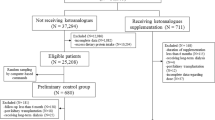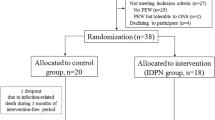Abstract
Objective: To evaluate the effects on the nutritional and metabolic parameters of a very-low-protein diet supplemented with ketoacids (VLPD+KA) in comparison with a conventional low-protein diet (LPD) in chronic kidney disease (CKD) patients.
Design: Prospective, randomized, controlled clinical study.
Setting: Outpatient Clinic of the Nephrology Division of Federal University of São Paulo, Brazil.
Subjects: The study involved 24 patients with advanced CKD (creatinine clearance <25 ml/min) that were randomly assigned to either a VLPD+KA (VLPD+KA group, 12 patients) or to a conventional LPD with 0.6 g/kg/day (LPD group, 12 patients). The patients were followed for 4 months.
Results: Nutritional status was adequately maintained with both diets for the studied period. Protein intake and serum urea nitrogen decreased significantly only in the VLPD+KA group (from 0.68±0.17 to 0.43±0.12 g/kg/day, P<0.05; from 61.4±12.8 to 43.6±14.9 mg/dl, P<0.001; respectively). Ionized calcium did not change in the VLPD+KA group but tended to decrease in the LPD group. Serum phosphorus tended to decrease in the VLPD+KA group probably as a result of a significant reduction in dietary phosphorus (529±109 to 373±125 mg/day, P<0.05) associated to the phosphorus-binding effect of the ketoacids. No change in these parameters was found in the LPD group. Serum parathormone increased significantly only in the LPD group (from 241±138 to 494±390 pg/ml, P<0.01). The change in PTH concentration was negatively correlated with changes in ionized calcium concentration (r=−0.75, P=0.02) and positively correlated with changes in serum phosphorus (r=0.71, P=0.03) only in the LPD group.
Conclusion: This study indicates that a VLPD+KA can maintain the nutritional status of the patients similarly to a conventional LPD. Besides, an improvement in calcium and phosphorus metabolism and a reduction in serum urea nitrogen were attained only with the VLPD+KA. Thus, VLPD+KA can constitute another efficient therapeutic alternative in the treatment of CKD patients.
Sponsorship: This study was supported by CAPES, Oswaldo Ramos Foundation and Fresenius Kabi, Ltda.
This is a preview of subscription content, access via your institution
Access options
Subscribe to this journal
Receive 12 print issues and online access
$259.00 per year
only $21.58 per issue
Buy this article
- Purchase on Springer Link
- Instant access to full article PDF
Prices may be subject to local taxes which are calculated during checkout


Similar content being viewed by others
References
Aparicio M, Chauveau P & Combe C (2001): Are supplemented low-protein diets nutritionally safe? Am. J. Clin. Nutr. 37 (Suppl 2), S71–S76.
Aparicio M, Chauveau P, Précigout V, Bouchet J, Lasseur C & Combe C (2000): Nutrition and outcome on renal replacement therapy of patients with chronic renal failure treated by a supplemented very low protein diet. J. Am. Soc. Nephrol. 11, 708–716.
Aparicio M, Combe C, Lafage MH, Precigout V, Bouchet JL & Potaux L (1992): Metabolic effects of low-protein low-phosphorus diet in patients with chronic renal failure. Contr. Nephrol. 98, 157–166.
Avesani CM, Cuppari L, Silva AC, Sigulem DM, Cendoroglo M, Sesso R & Draibe AS (2001): Resting energy expenditure in pre-dialysis diabetic patients. Nephrol. Dial. Transplant. 16, 556–560.
Avesani CM, Draibe SA, Kamimura MA, Cendoroglo M, Pedrosa A & Cuppari L (2003): Decreased resting energy expenditure (REE) in non-dialysed chronic kidney disease (CKD) patients. J. Am. Soc. Nephrol. 14, 530 (abstract).
Barsotti G, Cupisti A, Morelli E, Meola M, Cozza V, Barsotti M & Giovannetti S (1998): Secondary hyperparathyroidism in severe chronic renal failure is corrected by very-low dietary phosphate intake and calcium carbonate supplementation. Nephron 79, 137–141.
Bernard S, Fouque D, Laville M & Zech P (1996): Effects of low-protein diet supplemented with ketoacids on plasma lipids in adult chronic renal failure. Miner. Electrolyte Metab. 22, 143–146.
Bernhard J, Beaufrere B & Laville M (2001): Adaptive response to a low-protein diet in predialysis chronic renal failure patients. J. Am. Soc. Nephrol. 12, 1249–1254.
Chauveau P, Barthe N, Rigalleau V, Ozenne S, Castaing F, Delclaux C, Precigout V, Combe C & Aparicio M (1999): Outcome of nutritional status and body composition of uremic patients on a very low protein diet. Am. J. Kidney Dis. 34, 500–507.
Ciardella F, Morelli E, Niosi F, Caprioli R, Baldi R, Cupisti A, Petronio G, Carbone C & Barsotti G (1986): Effects of a low phosphorus, low nitrogen diet supplemented with essential amino acids and ketoanalogues on serum triglycerides of chronic uremic patients. Nephron 42, 196–199.
Combe C, Morel D, Precigout V, Blanchetier V, Bouchet JL, Potaux L, Fournier A & Aparicio M (1995): Long-term control of hyperparathyroidism in advanced renal failure by low-phosphorus low-protein diet supplemented with calcium (without changes in plasma calcitriol). Nephron 70, 287–295.
Forget D, Caranhac G, Quillot MJ & Besnier MO (1990): Compliance with very low protein diet and ketoanalogues in chronic renal failure. Contrib. Nephrol. 81, 79–86.
Frisancho AR (1981): New norms of upper limb fat and muscle areas for assessment of nutritional status. Am. J. Clin. Nutr. 34, 2540–2545.
Gin H, Aparicio M, Potaux L, Precigout V, Bouchet JL & Aubertin J (1987): Low protein and low phosphorus diet in patients with chronic renal failure: influence on glucose tolerance and tissue insulin sensitivity. Metabolism 36, 1080–1085.
Klahr S, Levey AS, Beck GJ, Caggiula AW, Hunsicker L, Kusek JW & Striker G (1994): The effects of dietary protein restriction and blood-pressure control on the progression of chronic renal disease. N. Engl. J. Med. 330, 877–884.
Kopple JD, Levey AS, Greene T, Chumlea WC, Gassman JJ, Hollinger DL, Maroni BJ, Merrill D, Scherch LK, Schulman G, Wang SR & Zimmer GS (1997): Effect of dietary protein restriction on nutritional status in the Modification of Diet in Renal Disease Study. Kidney Int. 52, 778–791.
Kroke A, Klipstein-Grobusch K, Voss S, Moseneder J, Thielecke F, Noack R & Boeing H (1999): Validation of a self-administered food-frequency questionnaire administered in the European prospective investigation into cances and nutrition (EPIC) study: comparison of energy, protein, and macronutrient intakes estimated with the doubly-labeled water, urinary nitrogen, and repeated 24-h dietary recall methods. Am. J. Clin. Nutr. 70, 439–447.
Lafage M, Combe C, Fournier A & Aparicio M (1992): Ketodiet, physiological calcium intake and native vitamin D improve renal osteodystrophy. Kidney Int. 42, 1217–1225.
Lindenau K, Abendroth K, Kokot F, Vetter K, Rehse C & Fröhling PT (1990): Therapeutic effect of keto acids on renal osteodystrophy. Nephron 55, 133–135.
Malvy D, Maingourd C, Pengloan J, Bagros P & Nivet H (1999): Effects of severe protein restriction with ketoanalogues in advanced renal failure. J. Am. Coll. Nutr. 18, 481–486.
Martin LJ, Su W, Jones PJ, Lockwood GA, Tritchler DL & Boyd NF (1996): Comparison of energy intakes determined by food records and doubly labeled water in women participating in a dietary-intervention trial. Am. J. Clin. Nutr. 63, 483–490.
Masud T, Young VR, Chapman T & Maroni BJ (1994): Adaptive responses to very low protein diets: The first comparison of ketoacids to essencial amino acids. Kidney Int. 45, 1182–1192.
Mitch WE (2002): Dietary requirements for protein and calories in the predialysis patient. In Handbook of Nutrition and the Kidney eds WE Mitch & S Klahr, pp 135–156. Philadelphia, PA: Lippincott, Williams & Wilkins.
Mitch WE, Abras E & Walser M (1982): Long-term effects of a new ketoacid-amino acid supplement in patients with chronic renal failure. Kidney Int. 22, 48–53.
O'Sullivan AJ, Lawson JÁ, Chan M & Kelly JJ (2002): Body composition and energy metabolism in chronic renal insufficiency. Am. J. Kidney Dis. 39, 369–375.
Passey C, Bunker V, Jackson A & Lee H (2003): Energy balance in predialysis patients on a low-protein diet. J. Renal. Nutr. 13, 120–125.
Rigalleau V, Blanchetier V, Combe C, Guillot C, Deleris G, Aubertin J, Aparicio M & Gin H (1997): A low-protein diet improves insulin sensitivity of endogenous glucose production in predialytic uremic patients. Am. J. Clin. Nutr. 65, 1512–1516.
Sargent JA & Gotch FA (1979): Mass balance: a quantitative guide to clinical nutrition therapy. J. Am. Diet. Assoc. 75, 547–555.
Schaefer K, Erley CM, Herrath D & Stein G (1989): Calcium salts of ketoacids as a new treatment strategy for uremic hyperphophatemia. Kidney Int. 36 (Suppl 27), S136–S139.
Tom K, Young VR, Chapman T, Masud T, Akpele L & Maroni BJ (1995): Long-term adaptive responses to dietary protein restriction in chronic renal failure. Am. J. Physiol. 268, E668–E677.
United States of America. Department of Agriculture (1963): Human nutrition information service: composition of foods. Raw processed, prepared. In Agriculture Handbook eds USDA, Vol 8, Series 1-16 (revised 1976–1986). USA: Department of Agriculture.
Vitolino MZ, Rand CS, Rapp SR, Ribisl PM & Sevick MA (2000): Measuring adherence to behavioral and medical interventions. Control Clin. Trials 21 (Suppl 5), S188–S194.
Walser M (1993): Does prolonged protein restriction preceding dialysis lead to protein malnutrition at the onset of dialysis. Kidney Int. 44, 1139–1144.
Walser M & Hill S (1999): Can renal replacement be deferred by a supplemented very low protein diet? J. Am. Soc. Nephrol. 10, 110–116.
Author information
Authors and Affiliations
Corresponding author
Additional information
Guarantor: L Cuppari.
Contributors: SFF was mainly responsible for the collection and analysis of the data. ACB, MRD and FBN were the renal dietitians who followed the patients during the study. RW was the physician responsible for the patients. SAD and LC were the coordinators of the research.
Rights and permissions
About this article
Cite this article
Feiten, S., Draibe, S., Watanabe, R. et al. Short-term effects of a very-low-protein diet supplemented with ketoacids in nondialyzed chronic kidney disease patients. Eur J Clin Nutr 59, 129–136 (2005). https://doi.org/10.1038/sj.ejcn.1602050
Received:
Revised:
Accepted:
Published:
Issue Date:
DOI: https://doi.org/10.1038/sj.ejcn.1602050
Keywords
This article is cited by
-
Dietary supplementation with ketoacids protects against CKD-induced oxidative damage and mitochondrial dysfunction in skeletal muscle of 5/6 nephrectomised rats
Skeletal Muscle (2018)
-
Phosphate stimulates myotube atrophy through autophagy activation: evidence of hyperphosphatemia contributing to skeletal muscle wasting in chronic kidney disease
BMC Nephrology (2018)
-
A practical approach to dietary interventions for nondialysis-dependent CKD patients: the experience of a reference nephrology center in Brazil
BMC Nephrology (2016)
-
“Dietaly”: practical issues for the nutritional management of CKD patients in Italy
BMC Nephrology (2016)
-
Very low protein diets supplemented with keto-analogues in ESRD predialysis patients and its effect on vascular stiffness and AVF Maturation
BMC Nephrology (2016)



